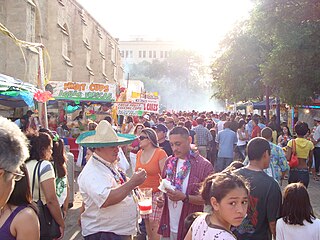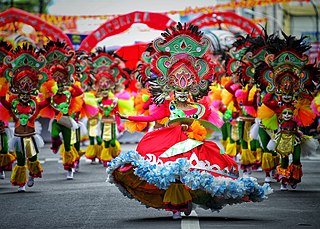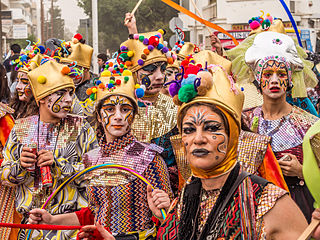
Carnival or Shrovetide is a festive season that occurs at the close of the Christian pre-Lenten period, consisting of Quinquagesima or Shrove Sunday, Shrove Monday, and Shrove Tuesday or Mardi Gras.

San Pablo, officially the City of San Pablo, is a component city in the province of Laguna, Philippines. According to the 2020 census, it has a population of 285,348 people.

The Kalibo Santo Niño—Ati-Atihan Festival, also simply called Ati-Atihan Festival, is a Philippine festival held annually in January in honor of the Santo Niño in several towns of the province of Aklan, Panay Island. The biggest celebration is held during the third Sunday of January in the town of Kalibo, the province's capital. The name Ati-Atihan means "to imitate the Ati people".

Lumban, officially the Municipality of Lumban, is a municipality in the province of Laguna, Philippines. According to the 2020 Census, it has a population of 32,330 people.

Fantasy Fest is a street party held annually in the last week of October in Key West, Florida.

A float is a decorated platform, either built on a vehicle like a truck or towed behind one, which is a component of many festive parades, such as those of Carnival in Rio de Janeiro, the Carnival in São Paulo, the Carnival of Viareggio, the Maltese Carnival, the Macy's Thanksgiving Day Parade, Mardi Gras in New Orleans, the Gasparilla Pirate Festival, the 500 Festival Parade, the United States Presidential Inaugural Parade, and the Tournament of Roses Parade. For the latter event, floats are decorated entirely in flowers or other plant material.

The carnival in Colombia was introduced by the Spaniards. The Colombian carnival has incorporated elements from European culture, and has managed to syncretise, or re-interpret, traditions that belonged to the African and Amerindian cultures of Colombia. There is documentary evidence that the carnival existed in Colombia in the 17th century and had already caused concern to the colonial authorities, who censored the celebrations, especially in the main centers of power such as Cartagena, Bogotá and Popayán. The carnival, therefore, continued its evolution and re-interpretation in the small and at that time unimportant towns where celebrations did not offend the ruling elites. The result was the uninterrupted celebration of carnival festivals in Barranquilla, and other villages along the lower Magdalena River in northern Colombia, and in Pasto, Nariño in the south of the country. In modern times, there have been attempts to introduce the carnival in the capital, Bogotá, in the early 20th century, but it has always failed to gain the approval of authorities. The Bogotá Carnival has had to wait until the 21st century to be resurrected, this time, by the authorities of the city. Colombia is recognized by its large variety of festivals, carnivals and fairs. Most towns have their own, ranging from those celebrating coffee to the ones held in honor of the town's Saint feast. The common characteristics of the festivals are the nomination of a beauty Queen and the setting up of public dance floor.

The Carnival in Rio de Janeiro is a festival held every year before Lent; it is considered the biggest celebration of Carnival in the world, with two million people per day on the streets. The first Carnival festival in Rio occurred in 1723.

Fiesta San Antonio has been since its 1891 inception an annual festival held in April in San Antonio, Texas. It is the city's signature event, along with some events held in the neighboring cities: Boerne, Schertz, Windcrest, Balcones Heights, and Alamo Heights). The festival, also known as the Battle of Flowers, commemorates of the Battle of the Alamo, which took place in San Antonio, and the Battle of San Jacinto, which led to Texas' independence from Mexico in April 1836.

The MassKara Festival is an annual festival with highlights held every 4th Sunday of October in Bacolod, Philippines. The festival sites include the Bacolod Public Plaza, the Lacson Tourism Strip and the Bacolod City Government Center.

The Dinagyang Festival is a religious and cultural festival in Iloilo City, Philippines, held annually on the fourth Sunday of January in honor of Santo Niño, the Holy Child. It is one of the largest festivals in the Philippines, drawing hundreds of thousands to over a million visitors every year.

A flower parade is a parade in which the floats, vehicles, boats, participants, animals and other things are decorated or covered in flowers. Often there are other elements like marching bands and people in costumes. Flower parades are held in several countries, many of which celebrate the forthcoming of the seasons. The oldest flower parade dates back to the 1800s.

Aliwan Fiesta is an annual event that gathers different cultural festivals of the Philippines in Star City Complex in Pasay wherein contingents compete in dance parade and float competitions. Organized by MBC Media Group together with Cultural Center of the Philippines (CCP) and the cities of Manila and Pasay, the event is dubbed as "the Philippines' Grandest Fiesta," with prizes totaling P3 million. Aliwan Fiesta, which began in 2003, aims to showcase the different Filipino cultures and heritage not only to the people in Metro Manila but also to the rest of the world. The contingents, meanwhile, aim to promote their respective regions both economically and tourism-wise. It was originally organized as a visual extravaganza for the Christmas season, but it has since been held during the summer months of either April or May. Aliwan is a Tagalog word for "entertainment" or "amusement." Aliwan Fiesta festivities are covered live on DZRH-TV annually.

Mardi Gras in the United States is celebrated in a number of cities and regions in the country. Most of these places trace their Mardi Gras celebrations to French, Spanish, and other Catholic colonial influences on the settlements over their history.

The Carnival of La Bañeza, in the province of Leon, is a festival declared of national tourist interest that began to gain importance and fame at the beginning of the 20th century during the repression under Franco, due to the prohibition of concealing one's face or wearing a costume. The main characteristic of La Bañeza's carnival is the absence of a costume competition with prizes and monetary compensation for participating, which may occur in carnivals elsewhere. Most of the city dedicates themselves wholeheartedly to the festival, passing on interest through generations. In many cases, participants prepare a year in advance, searching for accessories, fabrics, masks and acts they will perform, motivated by a "carnival feeling", lived during those days. Given this, the disorganized carnival is becoming increasingly popular, dressing up outside of parade hours, or on days without events, in the workplace, etc. looking to surprise and amaze the citizens and visitors.
Numerous events and festivals are held annually in Metro Manila. They include:
Carnival in Mexico is celebrated by about 225 communities in various ways, with the largest and best known modern celebrations occurring in Mazatlán and the city of Veracruz.

The Higalaay Festival is a patronal festival held each year in Cagayan de Oro, Philippines, every 28th day of August, celebrating the feast day of St. Augustine – patron saint of the city.

The Limassol Carnival is an annual European carnival event held in Limassol, Cyprus. The main parade is held 12 days before the start of Lent, on the Sunday before Ash Monday, 50 days before Orthodox Easter. The festival is a colourful 10-day event of people eating, singing, satire, games, wearing costumes, and attending parties. The festival culminates with a large parade, which includes an array of floats traversing the city.















